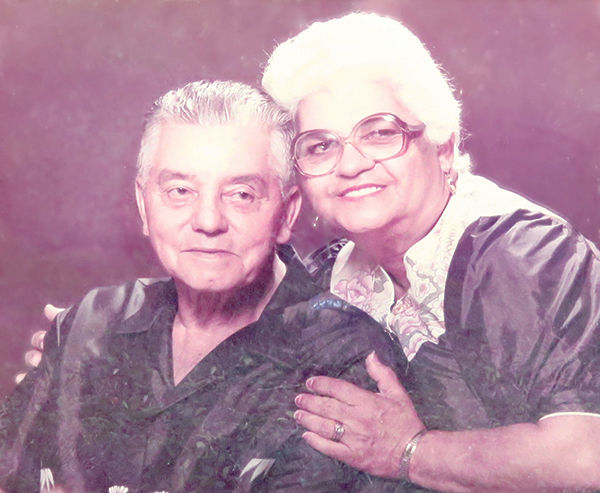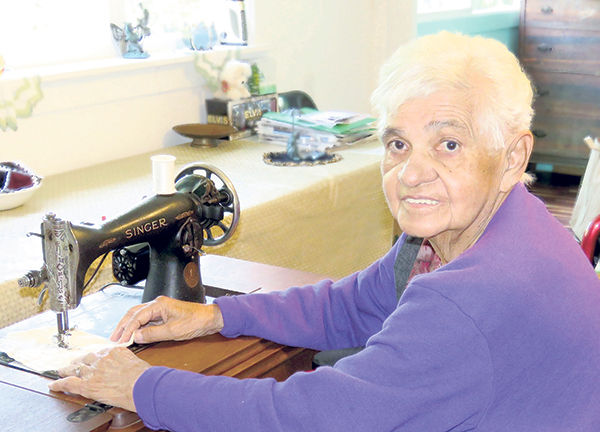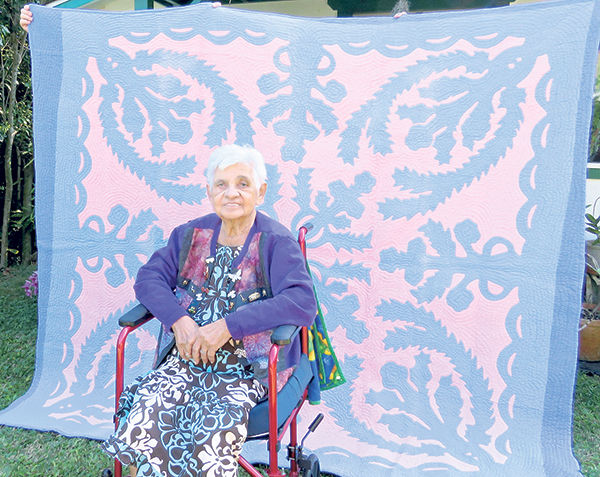Jane Vegas so loved making Hawaiian quilts that when she was raising her seven children, she often lost all track of time while she was sewing, sometimes quilting as many as eight hours per day. “Sometimes, I forgot to cook.
Jane Vegas so loved making Hawaiian quilts that when she was raising her seven children, she often lost all track of time while she was sewing, sometimes quilting as many as eight hours per day.
“Sometimes, I forgot to cook. My kids would ask me, ‘We’re not going to eat tonight?’ and I had to stop and go and cook,” she says with a laugh.
Sitting in the house in Lawai on Kauai’s South Shore that her husband, Solomon, built for their family in 1947, Jane speaks softly in a blend of standard and pidgin English, switching back and forth between past and present tense while talking about past events.
Now 91 years old and receiving hospice care, Jane looks back on how her passion for quilting led her to create a career that, as a young girl working in the sugar plantation fields, she had never known was possible.
Though she didn’t learn how to make Hawaiian quilts until she was in her 40s, Jane estimates that over the years she has sewn more than 1,000, each king size quilt taking about 1,000 hours to complete.
Her daughter and caretaker, Cathy Counts, says Jane’s skills were so exceptional that she became a revered and sought-after Hawaiian quilt maker and quilting instructor. She was even featured in a Japanese quilting magazine in 2005, and was an honored guest at quilting shows on Kauai’s North Shore in 2010 and 2012.
Found her calling
Hawaiian quilts are characterized by a graceful geometric appliqué pattern of leaves, flowers or fruit cut from a single piece of folded fabric, like the snowflakes children make from paper in school. While that can be a challenge, the real time-consuming part is sewing the quilting “echo-style,” rippling out from the design.
Jane honed her quilting skills by trial and error, largely teaching herself by looking at store displays and in books, because nobody she asked ever since she was a girl would teach her.
“I wanted to make a quilt so bad,” she says. “I used to see ready-made quilts and I tell, ‘I wonder how they make this?’ I used to come home and my stitches were half an inch big. Supposed to be tiny but I didn’t know that yet.”
But she persevered. As she refined her technique, Jane’s quilting expertise became known and her quilts in demand. She had found her calling.
Soon, women around the island began asking Jane to teach them how to make Hawaiian quilts. She began giving two-hour classes at senior centers on Kauai five days a week, from Waimea on the Westside to Kapaa on the east, and Hanapepe, Koloa and Lihue in between.
She recalls those days with her typical modesty.
“I even teach my eighth- grade teacher. I was nervous to teach her because she was my teacher when I was young,” Jane says. “She was a good student.”
Then, when Solomon died, she found herself in quite a quandary. She wanted to continue teaching classes around the island, but she had never learned how to drive a car. So she learned to drive at age 65.
“I started on a Datsun, a small little station wagon,” she says. “My son tell me, ‘You can learn with this one. It’s an old car so if you smash ‘em, it’s OK.’”
It was challenging at first, especially longer drives to the Eastside.
“When I used to drive to Kapaa and come back, my nerves was all jumping,” she says. “I have to lie down and relax after I come home.”
In time, she was able to drive herself all over Kauai.
Creating a new life
As a child, Jane had experienced very little that would lead her to believe that her life would ever become filled with things she enjoyed.
After her father killed her mother, Jane was brought up by her maternal grandparents. She and her brothers were often subject to harsh words from her grandparents, who were lost in bitterness over their daughter’s untimely death.
Jane was also required to work for the local sugar plantation.
“I started working in the sugar fields when I was 11 years old during the summer, kalai (hoeing), weeding the sugar cane, for 10 cents an hour, eight hours a day,” she says. “We worked all Kukuiula, the hills and everything for McBryde (Sugar Company).
“We didn’t know how to work, we wanted to make fast (be done quickly). Since we leave some of the grass back, they call us back and tell us, ‘You gotta pull more weeds out from the cane, gotta pull out more of the grass.’”
Jane found friendships with other young girls who worked in the cane fields, and used to exchange the Vienna sausage and fried egg her grandmother made for her with food that Japanese children brought into the fields.
“The Japanese food was good,” she says. “But they tell me, ‘Try put water in your rice and make like a soup.’ I made it. Oh, I can’t eat this! I had to throw my rice away.”
Jane was required to give her entire paycheck to her grandmother, who would return $5 to her every month.
In 1938, after she graduated from eighth grade, Jane put a $5 down payment on a Singer treadle sewing machine at Kukuiula Store, a general store. She began sewing clothes with her girlfriends, cutting out patterns on newspapers. Without realizing it yet, she was planting the seeds for a new life.
Every month she paid $5 toward the sewing machine’s purchase price of more than $200. When she got married at 19 years old, her husband paid off the balance.
Jane still has that sewing machine, which was eventually converted to operate via electricity, and in fact she used it until 2009, making clothes for her children as well as quilts for her grandchildren and great-grandchildren. Now she sews by hand, her daughter, Cathy, completing her work on an electric machine.
‘I feel happy inside’
Though the years, Jane has expanded her talents to using Hawaiian quilt-making techniques on more modern thematic designs for family members, including making quilts using colorful pareos as the appliqués.
She also does beautiful crocheting. She is currently working on lavender shelf liners for her son and his wife.
A couple years ago, she spotted a photo of a crocheted tablecloth with a butterfly and heart motif in a Japanese book and copied it, creating a beautiful, lace-like gift for a friend in Puerto Rico. “I no can read Japanese but I look at the pictures,” she says.
From time to time, when Jane is out and about, she is recognized by some of her former quilting students.
“They say, ‘I remember you.’ When they say they know me, I feel happy inside,” she said.
Now with seven children, 15 grandchildren, 28 great-grandchildren and two great-great grandchildren, Jane is able to spend her time quilting and crocheting — giving each new child who is born several of her beautiful handmade gifts of love.
“I just wanted to quilt, that’s all,” she says. “I feel happy when I make a Hawaiian quilt.”
•••
Pamela Varma Brown is the publisher of “Kauai Stories,” which includes Jane Vegas’ story, and the forthcoming “Kauai Stories 2.”




